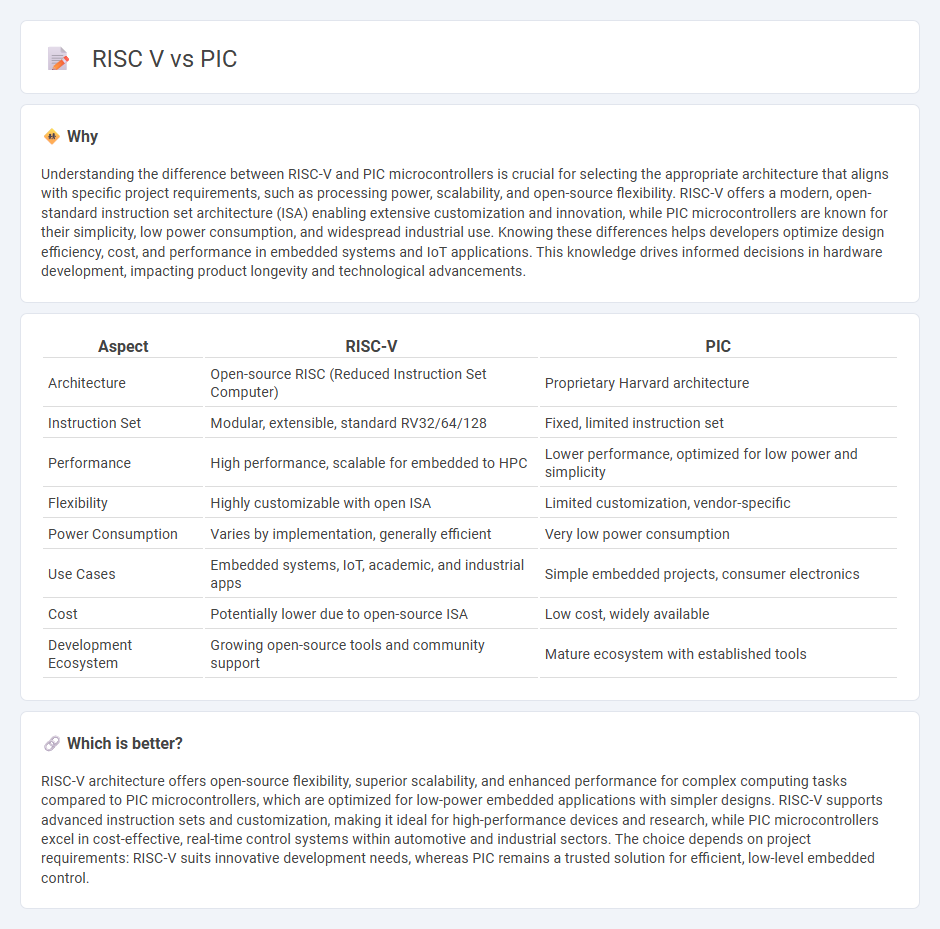
RISC-V and PIC are two prominent microcontroller architectures used in embedded systems, with RISC-V offering an open-source, modular design that enables customization and scalability for diverse applications. PIC microcontrollers, developed by Microchip Technology, provide a robust and widely adopted solution known for efficiency and simplicity in low-power devices. Explore the unique features and use cases of each architecture to determine the best fit for your next project.
Why it is important
Understanding the difference between RISC-V and PIC microcontrollers is crucial for selecting the appropriate architecture that aligns with specific project requirements, such as processing power, scalability, and open-source flexibility. RISC-V offers a modern, open-standard instruction set architecture (ISA) enabling extensive customization and innovation, while PIC microcontrollers are known for their simplicity, low power consumption, and widespread industrial use. Knowing these differences helps developers optimize design efficiency, cost, and performance in embedded systems and IoT applications. This knowledge drives informed decisions in hardware development, impacting product longevity and technological advancements.
Comparison Table
| Aspect | RISC-V | PIC |
|---|---|---|
| Architecture | Open-source RISC (Reduced Instruction Set Computer) | Proprietary Harvard architecture |
| Instruction Set | Modular, extensible, standard RV32/64/128 | Fixed, limited instruction set |
| Performance | High performance, scalable for embedded to HPC | Lower performance, optimized for low power and simplicity |
| Flexibility | Highly customizable with open ISA | Limited customization, vendor-specific |
| Power Consumption | Varies by implementation, generally efficient | Very low power consumption |
| Use Cases | Embedded systems, IoT, academic, and industrial apps | Simple embedded projects, consumer electronics |
| Cost | Potentially lower due to open-source ISA | Low cost, widely available |
| Development Ecosystem | Growing open-source tools and community support | Mature ecosystem with established tools |
Which is better?
RISC-V architecture offers open-source flexibility, superior scalability, and enhanced performance for complex computing tasks compared to PIC microcontrollers, which are optimized for low-power embedded applications with simpler designs. RISC-V supports advanced instruction sets and customization, making it ideal for high-performance devices and research, while PIC microcontrollers excel in cost-effective, real-time control systems within automotive and industrial sectors. The choice depends on project requirements: RISC-V suits innovative development needs, whereas PIC remains a trusted solution for efficient, low-level embedded control.
Connection
RISC-V and PIC microcontrollers are connected through their foundational roles in embedded system design, where RISC-V offers an open-source instruction set architecture enabling customizable, low-power processors, while PIC microcontrollers provide compact, efficient hardware solutions often used in real-time control applications. Both technologies emphasize simplicity and efficiency, facilitating diverse applications from consumer electronics to industrial automation. The growing adoption of RISC-V in developing bespoke microcontrollers presents a complementary evolution to the established PIC ecosystem, driving innovation in hardware flexibility and software compatibility.
Key Terms
Microcontroller Architecture
PIC microcontrollers feature a proprietary Reduced Instruction Set Computing (RISC) architecture optimized for simplicity and low power consumption, often utilized in embedded systems with limited processing requirements. RISC-V microcontrollers employ an open-standard RISC architecture that allows for extensibility and customization, promoting innovation and scalability in various industrial and academic applications. Explore further to understand how these microcontroller architectures influence performance, programming, and application scope.
Instruction Set
PIC microcontrollers feature a reduced instruction set tailored for embedded control with fixed-length 14-bit or 16-bit instructions optimized for simplicity and low power consumption. RISC-V employs a modular and extensible 32-bit or 64-bit instruction set architecture designed for versatility, supporting a wide range of applications from embedded systems to high-performance computing. Explore the detailed comparison of PIC and RISC-V instruction sets to understand their impact on processor design and application efficiency.
Source and External Links
PIC Microcontrollers - A family of microcontrollers made by Microchip Technology, originally derived from the PIC1640, widely used in embedded systems.
Pig Improvement Company (PIC) - A company specializing in genetic improvement for pork producers, providing high-quality genetics and technical services.
Pharmaceutical Inspection Convention and Scheme (PIC/S) - An international organization focused on harmonizing pharmaceutical inspections and good manufacturing practices globally.
 dowidth.com
dowidth.com